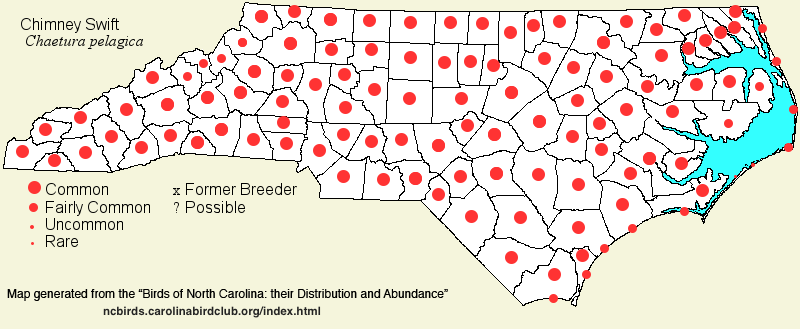 |  |
|
Chimney Swift - Chaetura pelagica APODIDAE Members: | Search Common: Search Scientific: |
|
|
|||||||
| General Comments | The Chimney Swift is one of the most "unique" species in eastern North America, as no other bird in this region shares its nesting habits and behavior. Of course, there are many very similar swifts in its genus elsewhere in the New World, but no other bird in the state nests in chimneys, nor flies for much of the day without ever perching (other than once inside a chimney). It is also remarkable in its migration timing; no other bird in the state is as punctual in spring and fall (within a few specific dates each year) arrival/departure. In fact, swifts can be numerous on one day in mid-Oct, and then all are gone the next day or two. Though the occasional swift may nest inside a large hollow tree in a swamp -- its historical nesting sites -- essentially all swifts in the state breed in chimneys, usually in cities and towns. From these sites, swifts forage over all types of habitats, including cities, farm fields, and over forests. After nesting, large groups of swifts may roost communally in a handful of tall chimneys. Populations appear to be in slow decline across its large range, though it is still a common bird in the state in most regions. A notable decline in flying insects, fed upon by swifts, goatsuckers, swallows, and some other birds that feed on the wing, is the primary reason. The loss of suitable chimneys for nesting is another factor; many are being capped, and many or most new homes are now built without chimneys. | ||||||
| Breeding Status | Breeder | ||||||
| NC BRC List | Definitive | ||||||
| State Status | W | ||||||
| U.S. Status | |||||||
| State Rank | S5B | ||||||
| Global Rank | G4G5 | ||||||
| Coastal Plain | Breeding summer resident. Common (though declining) throughout the province, except absent to uncommon on coastal islands; apparently does not nest in the Cape Hatteras area. Mainly early Apr to mid-Oct, with very few dates outside this span; earliest date: 2, Wilmington, 22 Mar 1987; latest date: 2, Rocky Mount, 15 Nov 2009. Peak counts: 100, Portsmouth Island, 2 May 1993 -- presumably a migratory flock. | ||||||
| Piedmont | Breeding summer resident. Common (though declining) throughout the province, though perhaps slightly less numerous in remote foothill areas. Mainly early Apr to mid-Oct. Late date: 2, Winston-Salem, 10 Nov 1966. Peak counts: an estimated 17,000 at a roost in downtown Winston-Salem, 7 Sep 2014; 13,000 at the same site, 17 Sep 2015; 4,000, Winston-Salem, 14 May 2003; 1,000, North Wilkesboro, 9 Oct 1958; 800, Falls Lake, 10 Oct 1987. | ||||||
| Mountains | Breeding summer resident. Common (though declining) in lower elevations (below 2,500 feet), and fairly common in the remainder of the province, though scarce above 5,000 feet. Perhaps nests in hollow trees in parts of the mountains. Mainly early Apr to mid-Oct. Peak counts: ?. | ||||||
| Finding Tips |
None needed; easily found in the warmer months. **** | ||||||
| Attribution | LeGrand[2023-03-03], LeGrand[2018-02-02], LeGrand[2016-06-02] | ||||||
| NC Map Map depicts all counties with a report (transient or resident) for the species. | Click on county for list of all known species. |
| NC Breeding Season Map Map depicts assumed breeding season abundance for the species. |  |